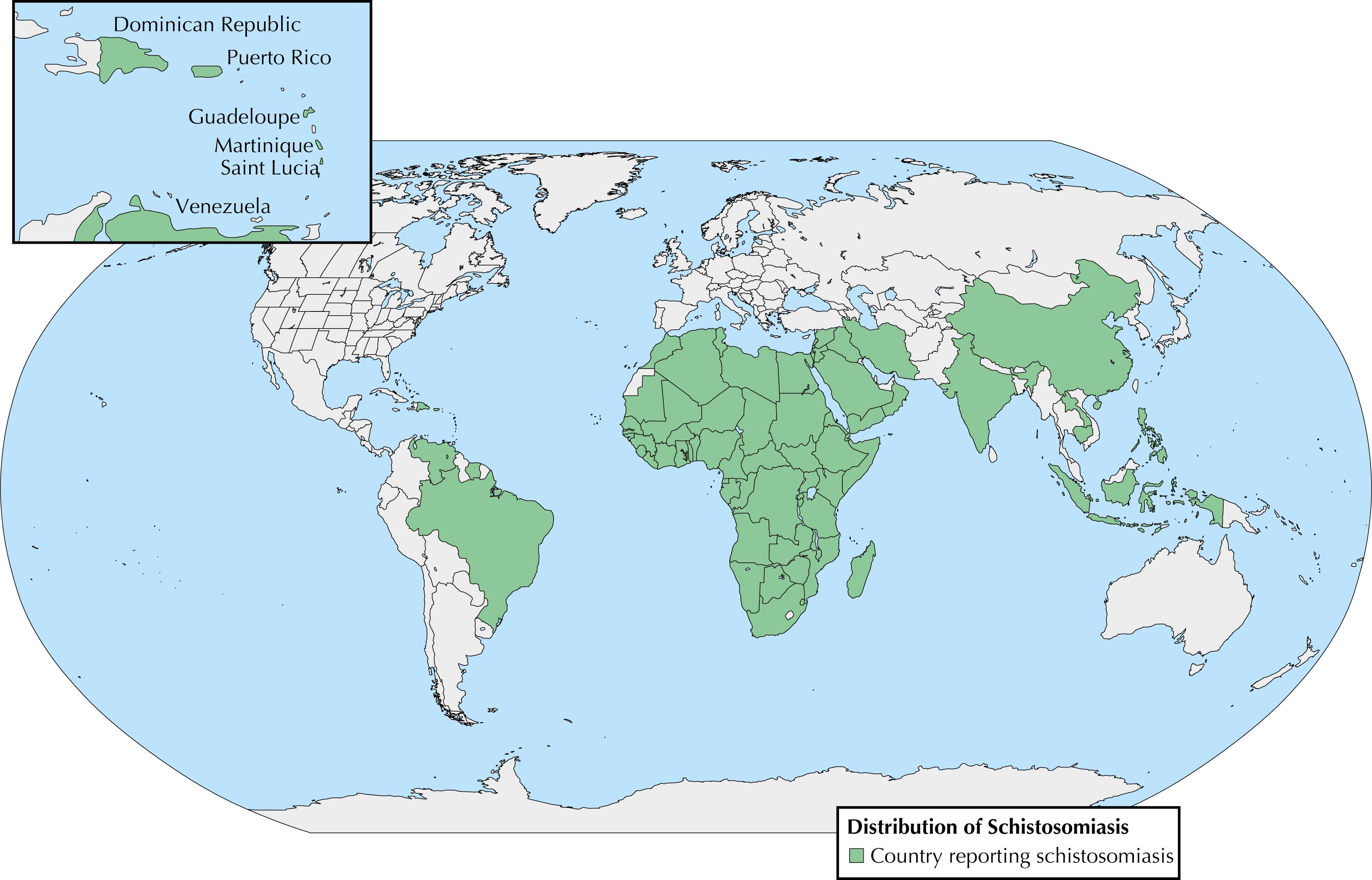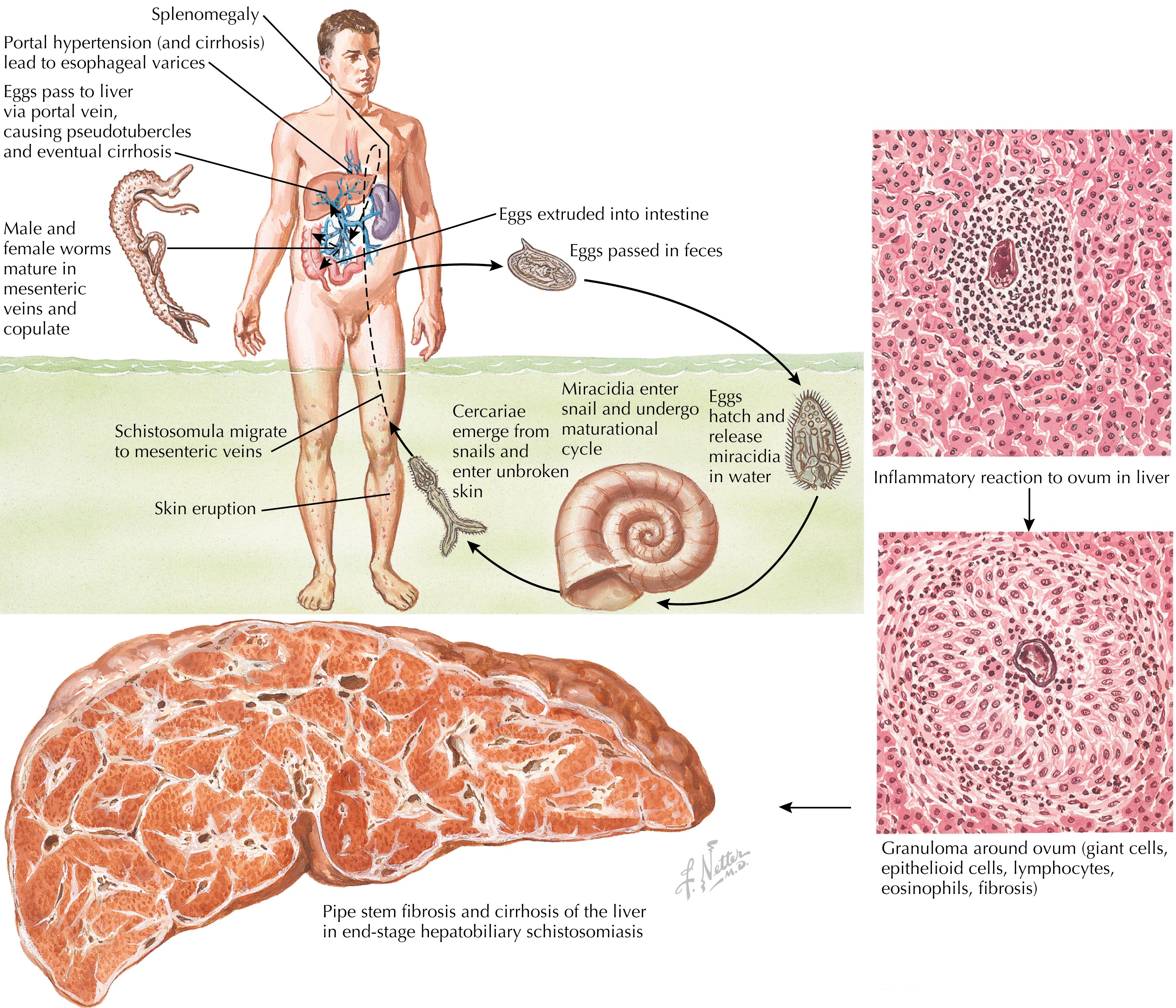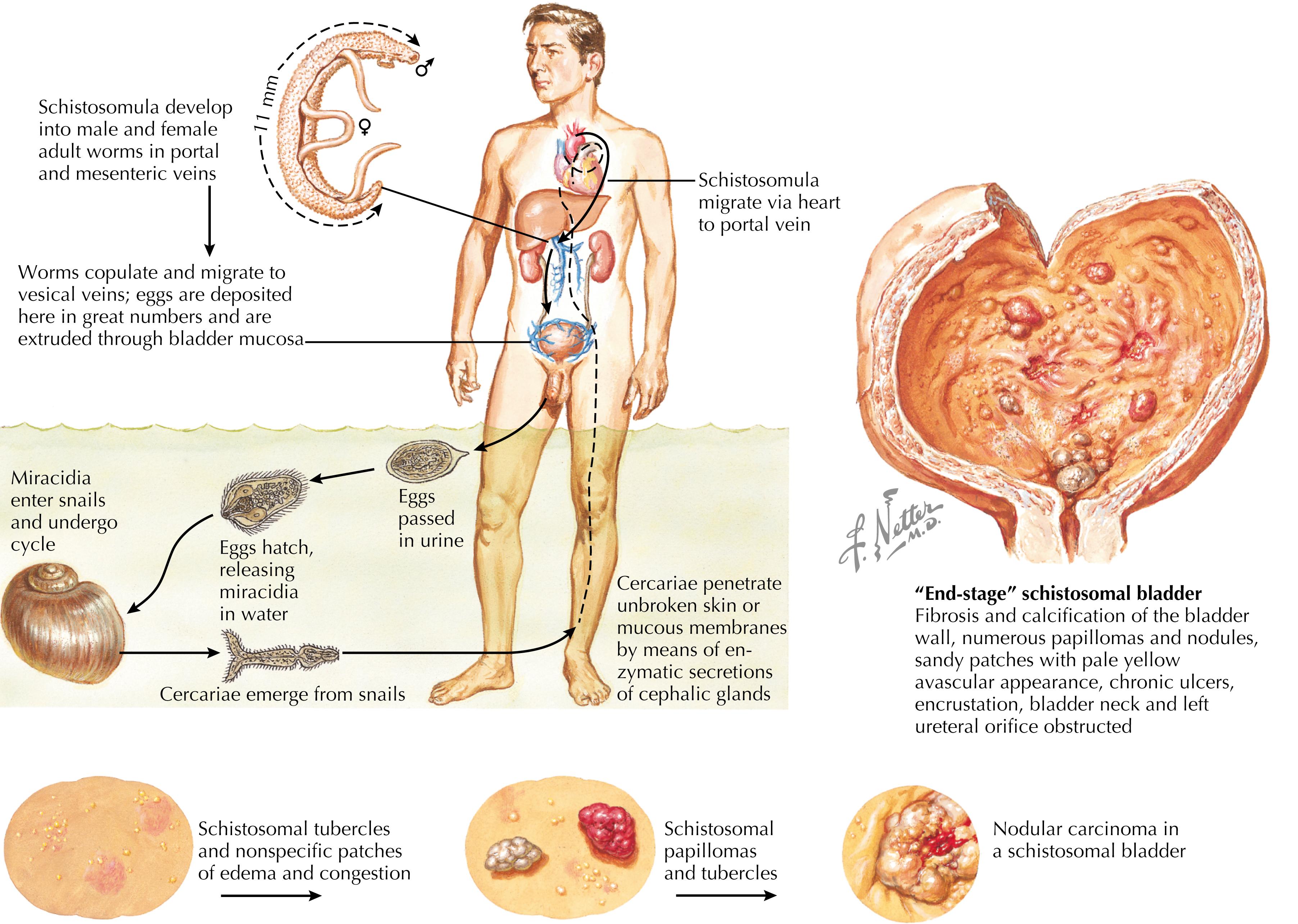Physical Address
304 North Cardinal St.
Dorchester Center, MA 02124
Schistosomiasis (bilharzia) is a disease caused by infection with parasitic flatworms known as blood flukes , belonging to the genus Schistosoma . According to the World Health Organization (WHO), schistosomiasis transmission has been reported from 78 countries, and it is estimated that more than 200 million people living in tropical endemic areas are infected. Chronic schistosomiasis causes significant morbidity and premature mortality, and negatively affects both individual health and socioeconomic development in poor and rural communities that lack access to safe drinking water and adequate sanitation.
The infection is acquired through direct skin contact with water inhabited by freshwater snails (intermediate hosts), shedding infective larvae into the water. The infective larvae, called cercariae , penetrate the intact wet skin of human hosts, mature in the vasculature of the liver, and migrate to the mesenteric (Schistosoma mansoni and Schistosoma japonicum) or pelvic (Schistosoma haematobium) veins. The female worms lay eggs that are excreted in the stool or urine. Acute disease manifestations include rash, fever, abdominal pain, and bloody stools or urine; chronic infection is characterized by an inflammatory immune response to eggs retained in the tissues (granuloma formation and fibrosis), leading to intestinal, hepato-splenic, or urogenital disease.
The burden of infection is directly related to the period of time persons living in endemic regions are immersed in or wading in bodies of water containing infected snails. Established infections do not stimulate protective host immunity, so new schistosome infections may be acquired during every instance of contact with infected-snail-contaminated water. The snails tend to live among vegetation close to the shoreline and to shed infective cercariae during the middle of the day when the sun is shining brightly. This is the time of day when residents in endemic areas are most likely to be in the water—fishing, boating, farming, bathing, washing clothes, gathering water, swimming, and engaging in other water activities. Males in the population seem to acquire heavier parasite burdens from childhood onward and experience more severe disease manifestations than females, ascribed to longer periods of water exposure of males through occupational and recreational activities. Visitors to endemic areas have acquired schistosomiasis while living and working among resident populations or while participating in recreational activities such as swimming, snorkeling, and kayaking in contaminated bodies of freshwater. When travelers return home to temperate nonendemic regions, acute disease manifestations may not be recognized at first when they occur.
“A 30-year-old male patient was evacuated from Namibia and evaluated at a US medical center because of a 2-week history of headaches, unilateral (left) vision loss, and one episode of loss of consciousness consistent with a seizure. The patient had been a Peace Corps Volunteer for 2 years in Tunisia and was serving an additional 2 years in Namibia. He had no history of recreational freshwater exposure in Tunisia or Namibia. However, he had snorkeled during a 2-day period at Cape Maclear in Lake Malawi [about 3 months before presentation]. A physical exam and white blood cell count (including eosinophil count) were normal. Computed tomography (CT) and magnetic resonance imaging (MRI) scans detected an enhancing left parietal lesion with extensive edema. Open brain biopsy was performed because the lesion was initially presumed to be a meningioma. The biopsy specimen demonstrated a granulomatous abscess containing parasite eggs that had peripheral spines consistent with schistosome eggs. S. haematobium eggs were identified in his urinary sediment but not in his stool. Schistosomiasis serology using the Falcon assay screening test-enzyme linked immunosorbent assay (FAST-ELISA) was positive at CDC. A confirmatory immunoblot was positive for S. hematobium antibody but not S. mansoni antibody. He was treated with praziquantel (PZQ; 60 mg/kg body weight per day, orally in three divided doses) for schistosomiasis, phenytoin for his seizure disorder, and dexamethasone for the cerebral edema.” At a medical follow-up 3 months afterward, “his symptoms had resolved and a CT scan documented continuing improvement. He returned to Namibia to complete his Peace Corps service.” ∗Reported by Wolfe M, Parenti D, Pollner J, Kobrine A, Schwartz, A. Schistosomiasis in U.S. Peace Corps Volunteers—Malawi, 1992. MMWR , July 30, 1993. 42(29):565-570. Available at: http://www.cdc.gov . Accessed November 13, 2019.
COMMENT: This historical case report of schistosomiasis in a Peace Corps volunteer illustrates several clinical points: presentation of schistosomiasis as a space-occupying lesion in the brain, infection in a person with unbeknownst exposure to infected freshwater snails in Lake Malawi in sub-Saharan Africa, onset of clinical signs and symptoms months after the presumed infectious episode, appropriate medical examination and parasite diagnostic tests, and management and treatment of schistosomiasis involving the central nervous system.
Schistosomiasis is prevalent in tropical and subtropical areas of Africa, the Middle East, South America, Southeast Asia, and the southern provinces of the People’s Republic of China. Surveillance data are incomplete but indicate that more than 90% of infected persons live in sub-Saharan Africa. In the past, the parasite was also transmitted in some islands in the Caribbean, the Philippines, and in Japan, but control programs appear to have been successful in eradicating the disease in these areas ( Fig. 83.1 ). Three species of Schistosoma are associated with the majority of human disease: Schistosoma mansoni , Schistosoma japonicum , and Schistosoma haematobium , and humans serve as the definitive host where sexual reproduction of the parasite takes place. Other schistosome species have been recognized less commonly as agents of intestinal schistosomiasis in humans, reported only from specific areas and having limited transmission: S. mekongi in Southeast Asia, and S. guineensis and related S. intercalatum in Africa. Each Schistosoma species has a specific snail intermediate host necessary for the completion of asexual life-cycle stages ( Table 83.1 ). The geographic range of disease transmission is actually determined by the geographic distribution of the requisite snails, and expansion of areas where schistosomiasis is transmitted has been associated with new habitats for snails created by the development of water resources: dams, irrigation waterways, streams, and ponds, and the concurrent migration of infected human populations into the new habitats. Snails spread to new areas not only by migration along contiguous waterways but also by introduction into new bodies of freshwater on the feet of aquatic birds.

| Disease Description | Species | Snail Intermediate Host | Geographic Distribution |
|---|---|---|---|
| Intestinal schistosomiasis | Schistosoma mansoni | Biomphalaria species | Africa, the Middle East, the Caribbean, Brazil, Venezuela, and Suriname |
| Schistosoma japonicum | Oncomelania species | China, Indonesia, the Philippines | |
| Schistosoma mekongi | Neotricula species | Several districts of Cambodia and the Lao People’s Democratic Republic | |
| Schistosoma guineensis and related S. intercalatum | Bulinus species | Rain forest areas of central Africa | |
| Urogenital schistosomiasis | Schistosoma haematobium | Bulinus species | Africa, the Middle East, Corsica (France) |
Schistosomiasis is transmitted to humans by infective parasite larvae called cercariae released into freshwater by infected aquatic snails. The cercariae are free-swimming and capable of penetrating intact wet human skin. Upon skin penetration, the cercaria sheds its motile forked tail section, and the tail-less body, called a schistosomulum , accesses the circulation and migrates to the hepatic vasculature, where maturation takes place. After the schistosomula mature into male and female adults, the adults pair up, mate, and migrate to the mesenteric veins of the intestine (intestinal and hepatic schistosomiasis) ( Fig. 83.2 ), or to the venous plexus of the urinary bladder (urogenital schistosomiasis) ( Fig. 83.3 ). Eggs are deposited on the peritoneal surface of the intestine or bladder, and the eggs work their way through the walls of the intestine or bladder into the viscus cavity, and exit the body in the fecal stream or in the urine, respectively.


The transmission cycle begins anew when untreated human feces and urine containing parasite ova (eggs) contaminate the freshwater aquatic environment. Under appropriate conditions of light and temperature, the schistosome eggs burst open in the water, releasing free-swimming parasite larvae called miracidia . The miracidia are infective only for the species-specific snail host. A week or so after the snails become infected, they will release cercariae, the parasite larval stages that are infective for humans, starting the cycle all over again.
Acute schistosomiasis: Within hours after cercarial penetration of the skin, with transformation of the cercarial stage parasites into schistosomula, some individuals develop a pruritic skin rash called cercarial dermatitis (also known as “swimmer’s itch”), representing each point of parasite entry. The rash may last for a few days, and itching can be relieved by antihistamines.
An asymptomatic incubation period then follows lasting approximately 4 to 8 weeks, during which time the schistosomula migrate to the hepatic circulation, mature to adult male and female worms, mate, and migrate against the direction of portal blood flow to the mesenteric veins or the venous plexus surrounding the bladder, depending on species. After copulation, the female worm migrates to the terminal venules and deposits eggs onto the peritoneal surface of the intestines or the bladder. With the aid of intrinsic mechanical movements of the egg and egg secretions, the eggs transit the walls of the viscus and break through the mucosa on the luminal side. Local tissue injury resulting from the passage of parasite eggs through the walls of the intestines into the bowel lumen is associated with abdominal pain and bloody stools in intestinal schistosomiasis, and passage of parasite eggs through the urinary bladder wall into the bladder lumen may result in grossly bloody urine in urogenital schistosomiasis. Light infections may be asymptomatic and go unnoticed.
Dispersion of S. haematobium eggs to ectopic locations outside the bladder may occur because of the complex anatomy of the vesicle venous plexus, which on occasion allows migratory worm pairs and loose eggs to gain access to other parts of the circulation. Eggs shunted to the systemic circulation may end up in ectopic locations such as the brain (seizures), heart (acute myocarditis, heart block), spinal cord (transverse myelitis, pain, paralysis), and skin (“egg dermatitis” rash).
A severe illness may occur 4 to 8 weeks after initial infection, around the time of parasite ovideposition, as described previously, which probably represents a pronounced hypersensitivity reaction to a variety of circulating parasite antigens. The illness is characterized in most cases by a high fever and may be accompanied by cough and urticaria. A peripheral blood eosinophilia is often present. This illness was first described in association with S. japonicum infections in the district of Katayama near Hiroshima, Japan, and was called Katayama fever ; a similar illness may occur in acute schistosomiasis caused by S. mansoni and also has been reported recently in some cases of S. haematobium infection. Acute schistosomiasis may be misdiagnosed as malaria, as initial results of definitive diagnostic tests may be negative in both acute febrile illnesses.
Chronic schistosomiasis: Adult schistosomes can live in humans for decades, persisting long after the initial infective episode(s) with prolonged production of eggs by the female worms. In intestinal schistosomiasis, the intestinal walls become scarred by egg granulomas over time, leading to further entrapment of parasite eggs in the tissues. Eggs that do not penetrate the walls are passively swept away in the direction of the portal blood flow towards the liver and become trapped in the portal triads, where granulomatous reactions around the eggs lead to fibrosis (see Fig. 83.2 ). Bridging “pipe-stem fibrosis” of the liver is the hallmark of chronic severe infection with S. mansoni . Cirrhosis, portal hypertension, splenomegaly, and esophageal varices represent late stages of chronic hepatic schistosomiasis, and exsanguination from bleeding esophageal varices is a common cause of premature death in infected adults in their second or third decade of life.
In chronic urogenital schistosomiasis, egg granulomas in the bladder wall may eventually cause ureteral obstruction, leading to hydronephrosis and subsequent renal failure (see Fig. 83.3 ). Impaired bladder function leading to incomplete urinary voiding is accompanied by recurrent urinary tract infections. Chronic inflammation of the bladder wall caused by egg granulomas is linked epidemiologically to an increased risk of bladder cancer in S. haematobium –infected persons. The involvement of the female genital organs can result in dyspareunia and impaired fertility.
Become a Clinical Tree membership for Full access and enjoy Unlimited articles
If you are a member. Log in here